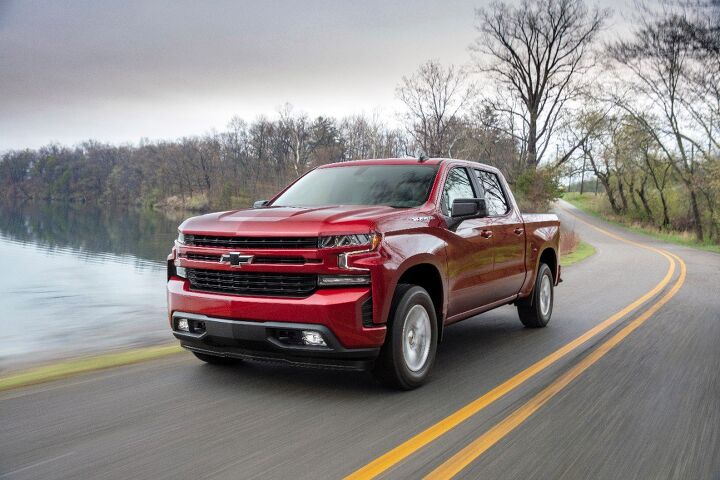How Does GM's Don't-call-it-a-four-cylinder Turbo Truck Engine Stack Up?

When GM released EPA-estimated fuel economy for its 2.7L Turbo full-size pickup engine today, many of us were taken aback. For a four-cylinder (yes, it is a four-cylinder, and the omission of this info from GM materials is glaring), we expected a higher MPG figure. Perhaps not significantly higher, but enough to create a greater gap between it and its cylinder-heavy contemporaries.
A combined rating of 21 mpg is what buyers can expect from the 2.7-liter unit, which sends its 310 horsepower and 348 lb-ft of torque to the rear wheels through an eight-speed automatic. (The 4WD model is not yet rated). That torque figure beats the naturally aspirated V6 found in both the GM and Ford camps, and comes close to Ram’s Pentastar motor. If gas mileage is top of mind, however, it’s a much closer race.
The MPG rating for a 2WD 2.7-liter Chevrolet Silverado is 20 city/23 mpg highway/21 combined. As we told you this morning, the V6 offerings at Ford and Ram beat the GM four-banger by a hair.
Each member of the Detroit Three went in different direction when pursuing fuel economy in their entry-level mills. GM dropped two cylinders, added a turbocharger, and slapped on a cylinder deactivation system. Ford choose dual injection and thermal management measures for its 3.3-liter V6. Ram saddled its familiar 3.6-liter Pentastar V6 with a mild hybrid system dubbed eTorque.
In two-wheel drive guise, a 3.3-liter F-150 (offered with an old six-speed auto) gets 19 city/25 highway/22 combined, while the V6 Ram (eight-speed auto) returns 20 city/25 highway/22 combined. While the 2019 version isn’t yet rated, last year’s 4.3-liter Silverado 2WD returned 20 mpg combined and actually saw a 1 MPG increase on the highway compared to its four-cylinder sibling. As a base engine for retail buyers (the 4.3-liter remains in contractor-friendly base trims), the 2.7L Turbo can boast greater average fuel economy (+1 mpg) horsepower (+25 hp) and torque (+43 lb-ft) than the engine it replaces, and that’s good for GM. But only to a degree.
The 2.7L truck is bookmarked by engines with greater tow ratings: up to 8,000 pounds for the 4.3-liter and up to 11,600 for the 5.3-liter V8, compared to the 2.7’s 7,200 lbs. Ford’s 3.3-liter tops out at 7,700 pounds, while the 3.6-liter Ram is rated for up to 7,730 lbs. Splitting hairs? Maybe, but different numbers matter to different folks.
Compared to its 5.3-liter, 2WD GM siblings, the combined fuel economy difference between the 2.7L truck and those with double the cylinder count is 2 mpg. Interestingly, a figure Ford made sure to mention was that its 2.7-liter EcoBoost V6 nets an extra MPG in combined driving, while also boasting 400 lb-ft of torque. The 2.7L F-150’s max tow rating? 8,500 lbs.
There will, of course, be customers who prefer the 2.7L GM engine over its rivals, and a great many more who won’t really think about it at all. The new mill comes standard on LT and RST trims. Indeed, we haven’t taken a 2.7L Silverado or GMC Sierra for a spin yet, so these facts and figures are no comment on how the engine sounds, feels, and responds.
[Image: General Motors]

More by Steph Willems
Latest Car Reviews
Read moreLatest Product Reviews
Read moreRecent Comments
- Oberkanone Tesla license their skateboard platforms to other manufacturers. Great. Better yet, Tesla manufacture and sell the platforms and auto manufacturers manufacture the body and interiors. Fantastic.
- ToolGuy As of right now, Tesla is convinced that their old approach to FSD doesn't work, and that their new approach to FSD will work. I ain't saying I agree or disagree, just telling you where they are.
- Jalop1991 Is this the beginning of the culmination of a very long game by Tesla?Build stuff, prove that it works. Sell the razors, sure, but pay close attention to the blades (charging network) that make the razors useful. Design features no one else is bothering with, and market the hell out of them.In other words, create demand for what you have.Then back out of manufacturing completely, because that's hard and expensive. License your stuff to legacy carmakers that (a) are able to build cars well, and (b) are too lazy to create the things and customer demand you did.Sit back and cash the checks.
- FreedMike People give this company a lot of crap, but the slow rollout might actually be a smart move in the long run - they can iron out the kinks in the product while it's still not a widely known brand. Complaints on a low volume product are bad, but the same complaints hit differently if there are hundreds of thousands of them on the road. And good on them for building a plant here - that's how it should be done, and not just for the tax incentives. It'll be interesting to see how these guys do.
- Buickman more likely Dunfast.


































Comments
Join the conversation
I'm highly suspect of the EPA's mileage figures with this truck and many other vehicles. One example being the 2019 volume Silverado with the new DFM 5.3 V8 that rated exactly the same MPG as last years AFM model despite losing 400 LBS of weight, gaining the DFM system which is claimed to improve MPG by up to 7% and the new 8 speed transmission. The new truck is also more aerodynamic. Even more telling is a recent C&D fuel economy test of the new Ram with the eTorque 3.6 V6 which fell well under it's EPA rated figures. In fact they said it wasn't far off the 5.7 engine! I would be willing to bet this new 2.7 will exceed it's highway figure by at least 1-2 MPG in real world driving.
Hmmmm.... in the 1400 or so miles I've put on my 2018 F150 XLT 2.7EB 4X4 Supercab I'm getting 20 in the city and 23 on the highway. Not impressed.